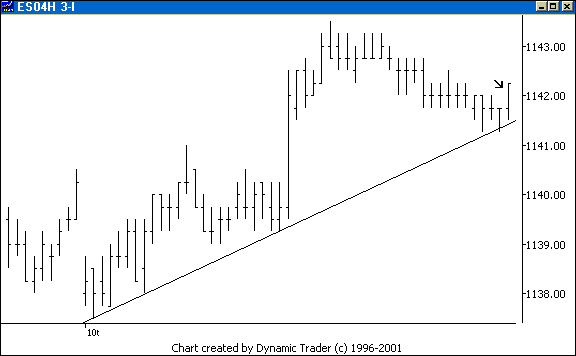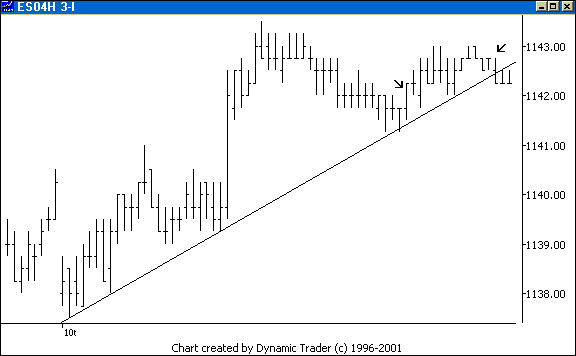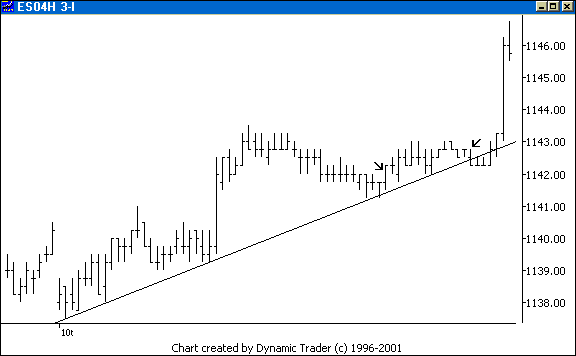|
|
| |
|
 February 10, 2004
Commentary- February 10, 2004
Commentary-
 Today I am going to show a trade that I did
in the ES, on what other than the 3-minute timeframe? I chose this trade
because it has several valuable aspects that I could cover using it as an
example. Today we will be light on charts and heavy on discussion. Don't worry,
though, it should be worthwhile. Today I am going to show a trade that I did
in the ES, on what other than the 3-minute timeframe? I chose this trade
because it has several valuable aspects that I could cover using it as an
example. Today we will be light on charts and heavy on discussion. Don't worry,
though, it should be worthwhile.
 I'll start with a chart showing the
area where I took the trade. I won't show the grouping because I want to focus
on what I did after the trade. I'll start with a chart showing the
area where I took the trade. I won't show the grouping because I want to focus
on what I did after the trade.


 There was a grouping in here that I was
interested in that hit right at a trendline, and I shortly thereafter got an
entry signal. I didn't like how the volume had dried up and I was hesitant
because of that, but I didn't see enough negatives to kill the trade
premise. There was a grouping in here that I was
interested in that hit right at a trendline, and I shortly thereafter got an
entry signal. I didn't like how the volume had dried up and I was hesitant
because of that, but I didn't see enough negatives to kill the trade
premise.
 Let's move on a little bit and see what's happening. Let's move on a little bit and see what's happening.


 The second arrow shows where the liquidity
just dried up to almost nothing. The ES was doing sometimes 25 contracts per
minute, instead of the usual greater than 500 when it's liquid. It didn't feel
right and I began to see it as very vulnerable to a sell program. Hence, I
scratched it. It never threatened my stop, and in fact it was grinding
upward. The second arrow shows where the liquidity
just dried up to almost nothing. The ES was doing sometimes 25 contracts per
minute, instead of the usual greater than 500 when it's liquid. It didn't feel
right and I began to see it as very vulnerable to a sell program. Hence, I
scratched it. It never threatened my stop, and in fact it was grinding
upward.
 So, did I do the right thing? I didn't give it a lot of room to
breathe. I jumped out on no direct exit signal of any kind. Now it gets
interesting, because I am going to attempt to lead the reader into making a
conclusion, and if I do this right, an incorrect conclusion. Let's see what
happened from here. So, did I do the right thing? I didn't give it a lot of room to
breathe. I jumped out on no direct exit signal of any kind. Now it gets
interesting, because I am going to attempt to lead the reader into making a
conclusion, and if I do this right, an incorrect conclusion. Let's see what
happened from here.


 Ah. It got
hit instead with a buy program and rocketed straight up on proportionately
large volume. I messed up. I should have given it room. I should have not been
so jumpy. Then I would have caught that move. Right? Ah. It got
hit instead with a buy program and rocketed straight up on proportionately
large volume. I messed up. I should have given it room. I should have not been
so jumpy. Then I would have caught that move. Right?
 Nope, dead
wrong. At least for me and my 'Trading Plan'. Here's the point of
all this discussion. I followed my game plan to a 'T'. I did what I was
supposed to do. I read the action as best as my experience and ability allowed
me to. I concluded that I could no longer see my edge. It didn't take off like
it 'should have'. Then the volume dried right up. Nope, dead
wrong. At least for me and my 'Trading Plan'. Here's the point of
all this discussion. I followed my game plan to a 'T'. I did what I was
supposed to do. I read the action as best as my experience and ability allowed
me to. I concluded that I could no longer see my edge. It didn't take off like
it 'should have'. Then the volume dried right up.
 This was not only the wrong action
it also set the mini up to be very vulnerable to a sell program. And that sell
program likely would have carried the mini below my stop in a flush, leaving me
struggling to get out. Sure, in today's market buy and sell programs hit all
the time and you have to jump quick. But there are times when they can be more
'dangerous' in my opinion, and I started to feel like I was about to get
trapped. This was not only the wrong action
it also set the mini up to be very vulnerable to a sell program. And that sell
program likely would have carried the mini below my stop in a flush, leaving me
struggling to get out. Sure, in today's market buy and sell programs hit all
the time and you have to jump quick. But there are times when they can be more
'dangerous' in my opinion, and I started to feel like I was about to get
trapped.
 It makes zero difference to me that some fund or hedgie decided to
hit it with a buy program right after that. I'm not trying to trade buy and
sell programs. It could just as easily have been a sell program. Here's
something important about what I'm saying here. I'm not going to look at this
one example and say that I should have stayed in, and change my entire 'Trading
Plan' because there was one isolated case where it wasn't the best play,
strictly dollar-wise. It makes zero difference to me that some fund or hedgie decided to
hit it with a buy program right after that. I'm not trying to trade buy and
sell programs. It could just as easily have been a sell program. Here's
something important about what I'm saying here. I'm not going to look at this
one example and say that I should have stayed in, and change my entire 'Trading
Plan' because there was one isolated case where it wasn't the best play,
strictly dollar-wise.
 My plan is developed with hundreds and
hundreds of examples, and I look at the overall probabilities, not
individual cases. No one case could change my game plan. If I start to see a
lot like this, I'll add that data into my database, crunch it all out and see
if it points to a change in the plan. My current experience is that most of the
time I see it lay out like today it's a sell program that hits. My plan is developed with hundreds and
hundreds of examples, and I look at the overall probabilities, not
individual cases. No one case could change my game plan. If I start to see a
lot like this, I'll add that data into my database, crunch it all out and see
if it points to a change in the plan. My current experience is that most of the
time I see it lay out like today it's a sell program that hits.
 I'm reminded
of an analogy I use quite often when trying to teach this concept. I try to
maintain a healthy diet and healthy lifestyle. I take a lot of 'ribbing' for
that. And when I espouse the virtues of healthy living, I pretty much get the
same response universally: 'I had a grandfather and he smoked three packs a
day, drank a six-pack a day, and ate steak and french fries until he couldn't
stand it anymore, and he lived to a hundred and three.' I'm reminded
of an analogy I use quite often when trying to teach this concept. I try to
maintain a healthy diet and healthy lifestyle. I take a lot of 'ribbing' for
that. And when I espouse the virtues of healthy living, I pretty much get the
same response universally: 'I had a grandfather and he smoked three packs a
day, drank a six-pack a day, and ate steak and french fries until he couldn't
stand it anymore, and he lived to a hundred and three.'
 From this I'm
supposed to conclude that we now know the secret to longevity? There is no
cause and effect there, even if the presenter thinks there is. This one
isolated case has little or no meaning to me. Tell me on average what
happens. In trading, I play probabilities. What usually happens?
My experience said my edge was gone, the capital at risk was getting at too
high of a risk level for me, and I bailed. For me, I totally did the
right thing. And I never even gave a second thought to changing my
'Trading Plan' over this one trade. From this I'm
supposed to conclude that we now know the secret to longevity? There is no
cause and effect there, even if the presenter thinks there is. This one
isolated case has little or no meaning to me. Tell me on average what
happens. In trading, I play probabilities. What usually happens?
My experience said my edge was gone, the capital at risk was getting at too
high of a risk level for me, and I bailed. For me, I totally did the
right thing. And I never even gave a second thought to changing my
'Trading Plan' over this one trade.
 |
|
|
| |
|
|
 NOTE: Reading this page or any page on the Kane
Trading website, or utilizing this website and any material NOTE: Reading this page or any page on the Kane
Trading website, or utilizing this website and any material
contained herein in any way, shall constitute an acknowledgement
that you have read, understood and agreed
to all the
disclaimers,
terms & conditions, and
policies of this site.
 |
|
 This website is best viewed with
MSIE 6.0, text size set to medium, and screen resolution set to 1024 by 768.
This website is best viewed with
MSIE 6.0, text size set to medium, and screen resolution set to 1024 by 768.
 Copyright © 2003 Kane
Trading. All rights reserved. Copyright © 2003 Kane
Trading. All rights reserved.
 |
|


